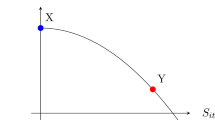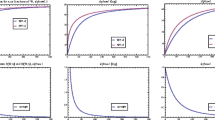Abstract
The utility of gambling, which entails an intrinsic utility or disutility of risk, has been alluded to in the economics literature for over a century. This paper demonstrates that any utility of gambling almost unavoidably implies a violation of fundamental rationality properties, such as transitivity or stochastic dominance, for static choices between gambles. This result may explain why the utility of gambling, a phenomenon so widely discussed, has never been formalized in the economics literature. The model of this paper accommodates well-known deviations from expected utility, such as the Allais paradox and the coexistence of gambling and insurance, while minimally deviating from expected utility.
Similar content being viewed by others
References
Bateman, Ian J., Alistair Munro, Bruce Rhodes, Chris Starmer, and Robert Sugden. (1997). “A Test of the Theory of Reference-Dependent Preferences,” The Quarterly Journal of Economics112, 647–661.
Birnbaum, Michael H. and Juan B. Navarrete. (1998). “Testing Descriptive Utility Theories: Violations of Stochas-tic Dominance and Cumulative Independence,” Journal of Risk and Uncertainty17, 49–78.
Bleichrodt, Han and Jose Luis Pinto. (2002). “A New Type of Preference Reversal,” iMTA, Erasmus University, Rotterdam, The Netherland s.
Bleichrodt, Han and Ulrich Schmidt. (2002). “A Context-Dependent Model of the Gambling Effect,” Management Science48, 802–812.
Bombardier, Claire, A. D. Wolfson, A. J. Sinclair, and A. McGreer. (1982). “Comparison of Three Preference Measurement Methodologies in the Evaluation of a Functional Status Index.” In Raisa B. Deber and G. Thompson (eds.), Choices in Health Care: Decision Making and Evaluation of Effectiveness, University of Toronto.
Burks, Arthur W. (1977). Chance, Cause, Reason (An Inquiry into the Nature of Scientific Evidencen). Chicago: The University of Chicago Press.
Conlisk, John. (1989). “Three Variants on the Allais Example,” American Economic Review79, 392–407.
Conlisk, John. (1993). “The Utility of Gambling,” Journal of Risk and Uncertainty6, 255–275.
Davidson, Donald and Patrick Suppes. (1956). “A Finitistic Axiomatization of Utility and Subjective Probability,” Econometrica24, 264–275.
Davidson, Donald, Patrick Suppes, and Sidney Siegel. (1957). “Decision Making: An Experimental Approach.” Stanford University Press, Stanford; Chapter 2 reprinted in Ward Edwards and Amos Tversky, (eds.) (1967), Decision Making, Penuin, Harmondsworth, pp. 170–207.
Dyer, James S. and Rakesh K. Sarin. (1982). “Relative Risk Aversion,” Management Science28, 875–886.
Edwards, Ward. (1962). “Subjective Probabilities Inferred from Decisions,” Psychological Review69, 109–135.
Ellsberg, Daniel. (1954). “Classic and Current Notions of 'Measurable Utility',” Economic Journal62, 528–556.
Fiorillo, Christopher D., Philippe N. Tobler, and Wolfram Schultz. (2003). “Discrete Coding of Reward Probability and Uncertainty by Dopamine Neurons,” Science299, 1898–1902.
Fishburn, Peter C. (1970). Utility Theory for Decision Making.New York: Wiley.
Fishburn, Peter C. (1980). “A Simple Model for the Utility of Gambling,” Psychometrika45, 435–448.
Friedman, Milton and Leonard J. Savage. (1948). “The Utility Analysis of Choices Involving Risk,” Journal of Political Economy56, 279–304.
Gafni, Amiram and Stephen Birch. (1997). “QALYs and HYEs; Spotting the Differences,” Journal of Health Economics16, 601–608.
Gafni, Amiram and George W. Torrance. (1984). “Risk Attitude and Time Preference in Health,” Management Science30, 440–451.
Golec, Joseph and Maurry Tamarkin. (1998). “Bettors Love Skewness, Not Risk, at the Horse Track,” Journal of Political Economy106, 205–225.
Hammond, Peter J. (1988). “Consequentialist Foundations for Expected Utility,” Theory and Decision25, 25–78.
Harless, David W. and Colin F. Camerer. (1994). “The Predictive Utility of Generalized Expected Utility Theories,” Econometrica62, 1251–1289.
Harsanyi, John C. (1978). “Bayesian Decision Theory and Utilitarian Ethics,” American Economic Review, Papers and Proceedings68, 223–228.
Humphrey, Stephen J. (1998). “More Mixed Results on Boundary Effects,” Economics Letters61, 79–84.
Johannesson, Magnus, Joseph S. Pliskin, and Milton C. Weinstein. (1993). “Are Healthy-Years Equivalents an Improvement over Quality-Adjusted Life Years?” Medical Decision Making13, 281–286.
Kahneman, Daniel and Amos Tversky. (1979). “Prospect Theory: An Analysis of Decision under Risk,” Econo-metrica47, 263–291.
Karni, Edi. (1987). “Generalized Expected Utility Analysis of Risk Aversion with State-Dependent Preferences,” International Economic Review28, 229–240.
Le Menestrel, Marc. (2001). “A Process Approach to the Utility of Gambling,” Theory and Decision50, 249–262.
Lenert Leslie A., S. Morss, Mary K. Goldstein, M. R. Bergen, W. O. Faustman, and Alan M. Garber. (1997). “Measurement of the Validity of Utility Elicitations Performed By Computerized Interview,” Medical Care35, 915–920.
Lichtenstein, Sarah and Paul Slovic. (1971). “Reversals of Preference between Bids and Choices in Gambling Decisions,” Journal of Experimental Psychology89, 46–55.
Lindman, Harold R. (1971). “Inconsistent Preferences among Gambles,” Journal of Experimental Psychology89, 390–397.
Loomes, Graham. (1993). “Disparaties between Health State Measures: An Explanation and Some Implications.” In Bill Gerrard (ed.), The Economics of Rationality, London: Routledge, pp. 149–178, (Chapter 9).
Loomes, Graham and Robert Sugden. (1982). “Regret Theory: An Alternative Theory of Rational Choice under Uncertainty,” Economic Journal92, 805–824.
Luce, R. Duncan. (2000). Utility of Gains and Losses: Measurement-Theoretical and Experimental Approaches. London: Lawrence Erlbaum Publisher
Luce, R. Duncan and Anthony A. J. Marley. (2000). “On Elements of Chance,” Theory and Decision49, 97–126.
Markowitz, Harry M. (1952). “The Utility of Wealth,” Journal of Political Economy60, 151–158.
Marshall, Alfred. (1890). Principles of Economics. 8th edition 1920 (9th edition 1961), New York: MacMillan.
McCord, Mark R. and Richard de Neufville. (1986). 'Lottery Equivalents': Reduction of the Certainty Effect Problem in Utility Assessment,” Management Science32, 56–60.
Mehrez, Abraham and Amiram Gafni. (1989). “Quality-Adjusted Life-Years, Utility Theory and Healthy Years Equivalents,” Medical Decision Making9, 142–149.
Miyamoto, John M. and Stephen A. Eraker. (1988). “A Multiplicative Model of the Utility of Survival Duration and Health Quality,” Journal of Experimental Psychology: General117, 3–20.
Mosteller, Frederick and Philip Nogee. (1951). “An Experimental Measurement of Utility,” Journal of Political Economy59, 371–404.
Neilson, William S. (1992). “Some Mixed Results on Boundary Effects,” Economics Letters39, 275–278.
Officer, Robert R. and Alfred N. Halter. (1968). “Utility Analysis in a Practical Setting,” American Journal of Agricultural Economics50, 257–277.
Pope, Robin E. (1995). “Towards a More Precise Decision Framework; A Separation of the Negative Utility of Chance from Diminishing Marginal Utility and the Preference for Safety,” Theory and Decision39, 241–265.
Quiggin, John. (1982). “A Theory of Anticipated Utility,” Journal of Economic Behaviour and Organization3, 323–343.
Richardson, Jeff. (1994). “Cost Utility Analysis: What Should Be Measured?” Social Science and Medicine39, 7–20.
Royden, Halsey L., Patrick Suppes, and Karol Walsh. (1959). “A Model for the Experimental Measurement of the Utility of Gambling,” Behavioral Science4, 11–18.
Savage, Leonard J. (1954). The Foundations of Statistics.New York: Wiley, (Second edition 1972, New York: Dover.)
Schlee, Edward E. (1992). “Marshall, Jevons, and the Development of the Expected Utility Hypothesis,” History of Political Economy24, 729–744.
Schmidt, Ulrich. (1998). “A Measurement of the Certainty Effect,” Journal of Mathematical Psychology42, 32–47.
Sopher, Barry and Gary Gigliotti. (1993). “A Test of Generalized Expected Utility Theory,” Theory and Decision35, 75–106.
Starmer, Chris. (1999). “Cycling with Rules of Thumb: An Experimental Test for a New Form of Non-Transitive Behavior,” Theory and Decision46, 141–158.
Starmer, Chris. (2000). “Developments in Non-Expected Utility Theory: The Hunt for a Descriptive Theory of Choice under Risk,” Journal of Economic Literature38, 332–382.
Starmer, Chris and Robert Sugden. (1993). “Testing for Juxtaposition and Event-Splitting Effects,” Journal of Risk and Uncertainty 6, 235–254
Stiggelbout, Anne M., Gwendoline M. Kiebert, Job Kievit, Jan-Willem H. Leer, G. Stoter, and Hanneke C. J. M. de Haes. (1994). “Utility Assesment In Cancer Patients: Adjustment of Time Tradeoff Scores for the Utility of Life Years and Comparison with Standard Gamble Scores,” Medical Decision Making14, 82–90.
Tversky, Amos. (1967). “Utility Theory and Additivity Analysis of Risky Choices,” Journal of Experimental Psychology75, 27–36.
Tversky, Amos and Daniel Kahneman. (1981). “The Framing of Decisions and the Psychology of Choice,” Science211, 453–458.
Tversky, Amos and Daniel Kahneman. (1986). “Rational Choice and the Framing of Decisions,” Journal of Business59, S251–S278.
Tversky, Amos and Daniel Kahneman. (1992). “Advances in Prospect Theory: Cumulative Representation of Uncertainty,” Journal of Risk and Uncertainty5, 297–323.
Vickrey, William. (1945). “Measuring Marginal Utility by Reactions to Risk,” Econometrica13, 319–333.
Viscusi, W. Kip. (1989). “Prospective Reference Theory: Toward an Explanantion of the Paradoxes,” Journal of Risk and Uncertainty2, 235–264.
von Neumann, John and Oskar Morgenstern. (1944, 1947, 1953). Theory of Games and Economic Behavior. Princeton NJ: Princeton University Press.
Wakker, Peter P. and Daniel Deneffe. (1996). “Eliciting von Neumann-Morgenstern Utilities when Probabilities Are Distorted or Unknown,” Management Science42, 1131–1150.
Author information
Authors and Affiliations
Corresponding author
Rights and permissions
About this article
Cite this article
Diecidue, E., Schmidt, U. & Wakker, P.P. The Utility of Gambling Reconsidered. Journal of Risk and Uncertainty 29, 241–259 (2004). https://doi.org/10.1023/B:RISK.0000046145.25793.37
Issue Date:
DOI: https://doi.org/10.1023/B:RISK.0000046145.25793.37




